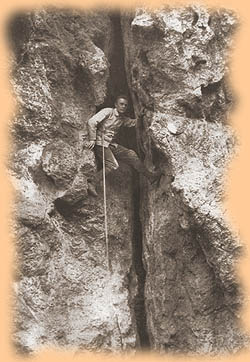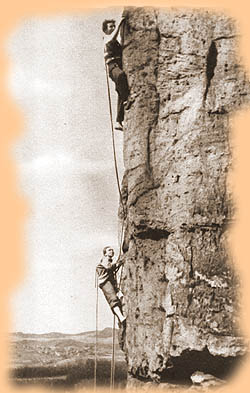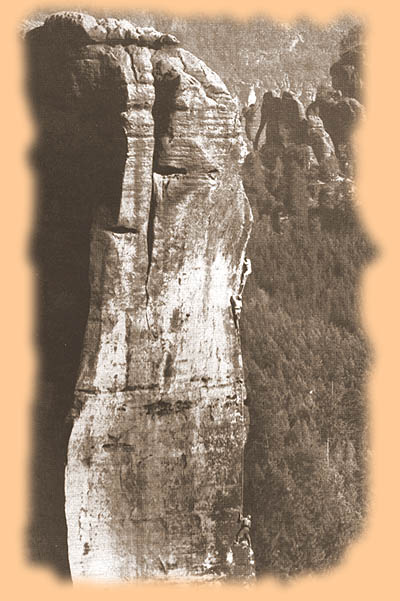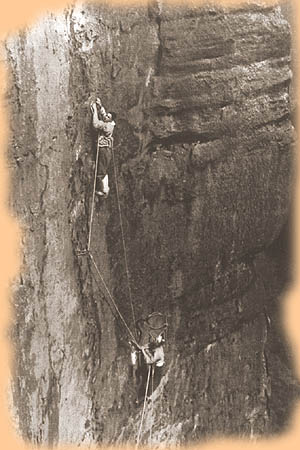Historical Rock Climbing
Images
|
Page
5.4
Felix Simon - Leipzig Pioneer & Elbsandsteingebirge |
 Kletterschule Mödling, 1907 (Simon was 23) |
 Juniweg
on the Osterturm ca. 1912?
Photo W. Wünsche |
| In his 1957 book, Felstürme und Eiswände, Simon - at the age of 73 - speaks of the training he and his companions undertook near Leipzig and along the Elbe so many years ago : "As the Alps trip approached we trained especially hard. Climbing with the rope, securing the belay, inserting protection, rope and gear work - the myriad small exercises at the climbing schools were practiced so enthusiastically that the larger alpine tests were effortlessly passed. The power of the fingers and arms, the extended and standing strength of the legs grew to the extent that the lowland climbers were on a par with the high mountaineers on alpine rock. A high number of experts emerged from our climbing schools - the most successful being the Leipzig climber, Dathe, who on alpine rock showed the same expertise as on Elbsandstein." |
 Teufelsturm,
Talseite FA 1936
Photo W. Hahn |
 South
face of Goldstein,
Photo W. HerbergFA by Häntzschel, Thomas, Pöche, Schmidtgen, Mühlbach (VIIc = 5.9/5.10) 1937 |
Simon, in the last chapter - entitled "Times Change" - becomes philosophical, reflecting on the ideas and practices of the first half-century: "The fifty years in the history of mountain climbing that I have experienced and look back on today as one in his seventies, comprise a development of alpinism that has seen conflict and resistance. Classical alpinism, over extreme rock climbing, led the way to the fights for the highest summits on Earth. Climbers of conflicting views often entered into violent literary feuds. At the beginning of my climbing career, the severe attitudes of Paul Preuss and Gustav Jahn forbid all artificial aids, even karabiners. But even these severe advocates of purely natural climbing found themselves at times unfaithful to their principles. Simply because it became a matter of life or death. Comparatively early mountain deaths probably stemmed from these practices. Preuss fell to his death while on a solo effort to achieve a first ascent, using no safety measures, on the Mandlkogel (Dachsteingebiet). And Gustav Jahn and his rope-mate died on the NW ridge of the Grossen Ödsteins, while on a tour of the hardest rock climbing in the Alps. When it became clear that these severe views made further progress in the Alps impossible, many climbers moved into Dülfer's camp, which welcomed technical remedies however artificial. This perspective provided solutions to previously difficult problems that were impossible using the old methods." |
Continue to Page 5.5